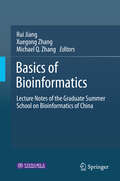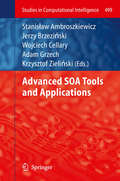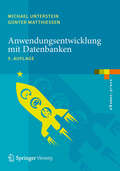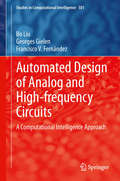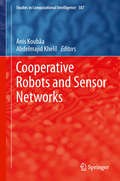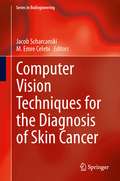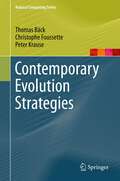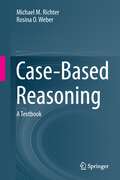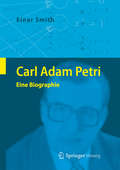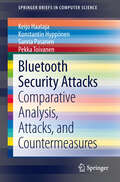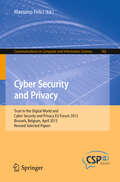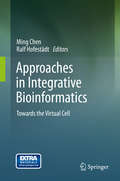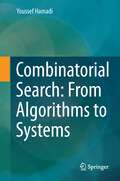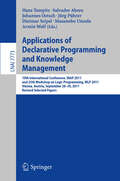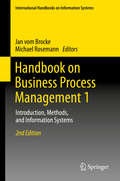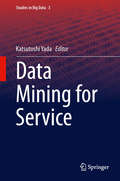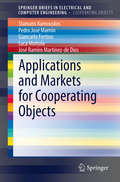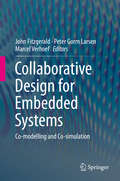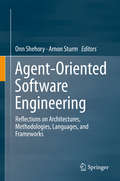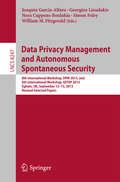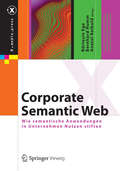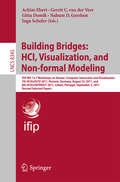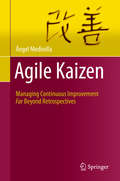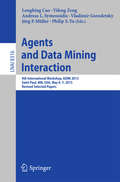- Table View
- List View
Basics of Bioinformatics: Lecture Notes of the Graduate Summer School on Bioinformatics of China
by Rui Jiang Xuegong Zhang Michael Q. ZhangThis book outlines 11 courses and 15 research topics in bioinformatics, based on curriculums and talks in a graduate summer school on bioinformatics that was held in Tsinghua University. The courses include: Basics for Bioinformatics, Basic Statistics for Bioinformatics, Topics in Computational Genomics, Statistical Methods in Bioinformatics, Algorithms in Computational Biology, Multivariate Statistical Methods in Bioinformatics Research, Association Analysis for Human Diseases: Methods and Examples, Data Mining and Knowledge Discovery Methods with Case Examples, Applied Bioinformatics Tools, Foundations for the Study of Structure and Function of Proteins, Computational Systems Biology Approaches for Deciphering Traditional Chinese Medicine, and Advanced Topics in Bioinformatics and Computational Biology. This book can serve as not only a primer for beginners in bioinformatics, but also a highly summarized yet systematic reference book for researchers in this field. Rui Jiang and Xuegong Zhang are both professors at the Department of Automation, Tsinghua University, China. Professor Michael Q. Zhang works at the Cold Spring Harbor Laboratory, Cold Spring Harbor, NY, USA.
Advanced SOA Tools and Applications (Studies in Computational Intelligence #499)
by Wojciech Cellary Adam Grzech Stanisław Ambroszkiewicz Jerzy Brzeziński Krzysztof ZielińskiThis book presents advanced software development tools for construction, deployment and governance of Service Oriented Architecture (SOA) applications. Novel technical concepts and paradigms, formulated during the research stage and during development of such tools are presented and illustrated by practical usage examples. Hence this book will be of interest not only to theoreticians but also to engineers who cope with real-life problems. Additionally, each chapter contains an overview of related work, enabling comparison of the proposed concepts with exiting solutions in various areas of the SOA development process. This makes the book interesting also for students and scientists who investigate similar issues.
Anwendungsentwicklung mit Datenbanken (eXamen.press)
by Günter Matthiessen Michael UntersteinDas Buch ergänzt und erweitert "Relationale Datenbanken und SQL in Theorie und Praxis (ISBN 978-3-642-28985-9)". Schwerpunkt der Darstellung sind Aspekte der Anwendungsprogrammierung mit Datenbanken. Dabei werden prozedurale Konzepte in SQL wie Stored Procedures und Trigger, Anbindung von Datenbanken in Java, Transaktionen und anderes mehr behandelt. Auch der Entwurf mit UML ist Thema. Eine Beispieldatenbank und die Quellcodes stehen zum Download zur Verfügung.
Automated Design of Analog and High-frequency Circuits: A Computational Intelligence Approach (Studies in Computational Intelligence #501)
by Bo Liu Georges Gielen Francisco V. FernándezComputational intelligence techniques are becoming more and more important for automated problem solving nowadays. Due to the growing complexity of industrial applications and the increasingly tight time-to-market requirements, the time available for thorough problem analysis and development of tailored solution methods is decreasing. There is no doubt that this trend will continue in the foreseeable future. Hence, it is not surprising that robust and general automated problem solving methods with satisfactory performance are needed.
Cooperative Robots and Sensor Networks (Studies in Computational Intelligence #507)
by Anis Koubâa Abdelmajid KhelilMobile robots and Wireless Sensor Networks (WSNs) have enabled great potentials and a large space for ubiquitous and pervasive applications. Robotics and WSNs have mostly been considered as separate research fields and little work has investigated the marriage between these two technologies. However, these two technologies share several features, enable common cyber-physical applications and provide complementary support to each other. The primary objective of book is to provide a reference for cutting-edge studies and research trends pertaining to robotics and sensor networks, and in particular for the coupling between them. The book consists of five chapters. The first chapter presents a cooperation strategy for teams of multiple autonomous vehicles to solve the rendezvous problem. The second chapter is motivated by the need to improve existing solutions that deal with connectivity prediction, and proposed a genetic machine learning approach for link-quality prediction. The third chapter presents an architecture for indoor navigation using an Android smartphone for guiding a variety of users, from sighted to the visually impaired, to their intended destination. In chapter four, the authors deal with accurate prediction modeling of ocean currents for underwater glider navigation. In chapter five, the authors discuss the challenges and limitations of RSS-based localization mechanisms and propose, EasyLoc, an autonomous and practical RSS-based localization technique that satisfies ease of deployment and implementation.
Computer Vision Techniques for the Diagnosis of Skin Cancer (Series in BioEngineering)
by M. Emre Celebi Jacob ScharcanskiThe goal of this volume is to summarize the state-of-the-art in the utilization of computer vision techniques in the diagnosis of skin cancer. Malignant melanoma is one of the most rapidly increasing cancers in the world. Early diagnosis is particularly important since melanoma can be cured with a simple excision if detected early. In recent years, dermoscopy has proved valuable in visualizing the morphological structures in pigmented lesions. However, it has also been shown that dermoscopy is difficult to learn and subjective. Newer technologies such as infrared imaging, multispectral imaging, and confocal microscopy, have recently come to the forefront in providing greater diagnostic accuracy. These imaging technologies presented in this book can serve as an adjunct to physicians and provide automated skin cancer screening. Although computerized techniques cannot as yet provide a definitive diagnosis, they can be used to improve biopsy decision-making as well as early melanoma detection, especially for patients with multiple atypical nevi.
Contemporary Evolution Strategies (Natural Computing Series)
by Thomas Bäck Christophe Foussette Peter KrauseThis book surveys key algorithm developments between 1990 and 2012, with brief descriptions, a unified pseudocode for each algorithm and downloadable program code. Provides a taxonomy to clarify similarities and differences as well as historical relationships.
Case-Based Reasoning: A Textbook (Lecture Notes in Computer Science #4626)
by Michael M. Richter Rosina O. WeberThis book presents case-based reasoning in a systematic approach with two goals: to present rigorous and formally valid structures for precise case-based reasoning, and to demonstrate the range of techniques, methods, and tools available for many applications.
Carl Adam Petri: Eine Biographie
by Einar SmithDer Autor präsentiert Leben, Werk und Wirken eines der weltweit bekanntesten deutschen Informatiker: Carl Adam Petri. Die Stadien seiner Entwicklung sind lebendig und kurzweilig beschrieben, gehen aber so weit in die Tiefe, dass der Leser ein gutes Verständnis für die Hintergründe von Petris wichtigstem Beitrag zur Informatik bekommt, die nach ihm benannten Petrinetze. Das Buch kann so als Einführung in die Petrinetze gelesen werden, erörtert aber auch die theoretischen, physikalischen und philosophischen Grundlagen der Netze, die erst einen umfassenden Zugang zu Petris Werk ermöglichen. Das Buch wendet sich dank seiner verständlichen Darstellung aber auch an Leser, die einfach nur eine bemerkenswerte Persönlichkeit der Zeitgeschichte kennenlernen möchten.
Bluetooth Security Attacks: Comparative Analysis, Attacks, and Countermeasures (SpringerBriefs in Computer Science)
by Keijo Haataja Konstantin Hyppönen Sanna Pasanen Pekka ToivanenBluetooth technology has enjoyed tremendous success, and it's now employed in billions of devices for short-range wireless data and real-time audio or video transfer. In this book the authors provide an overview of Bluetooth security. They examine network vulnerabilities and provide a literature-review comparative analysis of recent security attacks. They analyze and explain related countermeasures, including one based on secure simple pairing, and they also propose a novel attack that works against all existing Bluetooth versions. They conclude with a discussion on future research directions. The book is appropriate for practitioners and researchers in information security, in particular those engaged in the design of networked and mobile devices.
Cyber Security and Privacy: Trust in the Digital World and Cyber Security and Privacy EU Forum 2013, Brussels, Belgium, April 2013, Revised Selected Papers (Communications in Computer and Information Science #182)
by Massimo FeliciThis book constitutes the thoroughly refereed, selected papers on Cyber Security and Privacy EU Forum 2013, held in Belgium, in April 2013. The 14 revised full papers presented were carefully reviewed and selected from various submissions. The papers are organized in topical sections on cloud computing, security and privacy management, security and privacy technology, security and privacy policy.
Approaches in Integrative Bioinformatics: Towards the Virtual Cell
by Ming Chen Ralf HofestädtApproaches in Integrative Bioinformatics provides a basic introduction to biological information systems, as well as guidance for the computational analysis of systems biology. This book also covers a range of issues and methods that reveal the multitude of omics data integration types and the relevance that integrative bioinformatics has today. Topics include biological data integration and manipulation, modeling and simulation of metabolic networks, transcriptomics and phenomics, and virtual cell approaches, as well as a number of applications of network biology. It helps to illustrate the value of integrative bioinformatics approaches to the life sciences. This book is intended for researchers and graduate students in the field of Bioinformatics. Professor Ming Chen is the Director of the Bioinformatics Laboratory at the College of Life Sciences, Zhejiang University, Hangzhou, China. Professor Ralf Hofestädt is the Chair of the Department of Bioinformatics and Medical Informatics, Bielefeld University, Germany.
Combinatorial Search: From Algorithms To Systems
by Youssef HamadiAlthough they are believed to be unsolvable in general, tractability results suggest that some practical NP-hard problems can be efficiently solved. Combinatorial search algorithms are designed to efficiently explore the usually large solution space of these instances by reducing the search space to feasible regions and using heuristics to efficiently explore these regions. Various mathematical formalisms may be used to express and tackle combinatorial problems, among them the constraint satisfaction problem (CSP) and the propositional satisfiability problem (SAT). These algorithms, or constraint solvers, apply search space reduction through inference techniques, use activity-based heuristics to guide exploration, diversify the searches through frequent restarts, and often learn from their mistakes. In this book the author focuses on knowledge sharing in combinatorial search, the capacity to generate and exploit meaningful information, such as redundant constraints, heuristic hints, and performance measures, during search, which can dramatically improve the performance of a constraint solver. Information can be shared between multiple constraint solvers simultaneously working on the same instance, or information can help achieve good performance while solving a large set of related instances. In the first case, information sharing has to be performed at the expense of the underlying search effort, since a solver has to stop its main effort to prepare and commu nicate the information to other solvers; on the other hand, not sharing information can incur a cost for the whole system, with solvers potentially exploring unfeasible spaces discovered by other solvers. In the second case, sharing performance measures can be done with little overhead, and the goal is to be able to tune a constraint solver in relation to the characteristics of a new instance - this corresponds to the selection of the most suitable algorithm for solving a given instance. The book is suitable for researchers, practitioners, and graduate students working in the areas of optimization, search, constraints, and computational complexity.
Applications of Declarative Programming and Knowledge Management: 19th International Conference, INAP 2011, and 25th Workshop on Logic Programming, WLP 2011, Vienna, Austria, September 28-30, 2011, Revised Selected Papers (Lecture Notes in Computer Science #7773)
by Hans Tompits Salvador Abreu Johannes Oetsch Jörg Pührer Dietmar Seipel Masanobu Umeda Armin WolfThis book constitutes revised selected papers of the 19th International Conference on Applications of Declarative Programming and Knowledge Management, INAP 2011, and the 25th Workshop on Logic Programming, WLP 2011, held in Vienna, Austria, in September 2011. The 19 papers presented in this volume were carefully reviewed and selected from 27 papers presented at the conference and initially a total of 35 submissions. The book also contains the papers of two invited talks. The papers are organized in topical sections on languages; answer-set programming and abductive reasoning; constraints and logic programming; answer-set programming and model expansion; application papers; and system descriptions.
, 2nd Edition: Introduction, Methods, and Information Systems (International Handbooks on Information Systems)
by Jan Vom Brocke Michael RosemannBusiness Process Management (BPM) has become one of the most widely used approaches for the design of modern organizational and information systems. The conscious treatment of business processes as significant corporate assets has facilitated substantial improvements in organizational performance but is also used to ensure the conformance of corporate activities. This Handbook presents in two volumes the contemporary body of knowledge as articulated by the world' s leading BPM thought leaders. This first volume focuses on arriving at a sound definition of BPM approaches and examines BPM methods and process-aware information systems. As such, it provides guidance for the integration of BPM into corporate methodologies and information systems. Each chapter has been contributed by leading international experts. Selected case studies complement their views and lead to a summary of BPM expertise that is unique in its coverage of the most critical success factors of BPM.<P><P> The second edition of this handbook has been significantly revised and extended. Each chapter has been updated to reflect the most current developments. This includes in particular new technologies such as in-memory data and process management, social media and networks. A further focus of this revised and extended edition is on the actual deployment of the proposed theoretical concepts. This volume includes a number of entire new chapters from some of the world's leading experts in the domain of BPM.
Data Mining for Service (Studies in Big Data #3)
by Katsutoshi YadaVirtually all nontrivial and modern service related problems and systems involve data volumes and types that clearly fall into what is presently meant as "big data", that is, are huge, heterogeneous, complex, distributed, etc. Data mining is a series of processes which include collecting and accumulating data, modeling phenomena, and discovering new information, and it is one of the most important steps to scientific analysis of the processes of services. Data mining application in services requires a thorough understanding of the characteristics of each service and knowledge of the compatibility of data mining technology within each particular service, rather than knowledge only in calculation speed and prediction accuracy. Varied examples of services provided in this book will help readers understand the relation between services and data mining technology. This book is intended to stimulate interest among researchers and practitioners in the relation between data mining technology and its application to other fields.
Applications and Markets for Cooperating Objects (SpringerBriefs in Electrical and Computer Engineering)
by Stamatis Karnouskos Pedro José Marrón Luca Mottola Giancarlo Fortino José Ramiro Martínez-de DiosThis book provides an overview and an insight in cooperative objects and defines the classification of topics into the different areas. A significant number of researchers and industrial partners were contacted in order to prepare the roadmap. The book presents of the main results provided by the corresponding European project "CONET".
Collaborative Design for Embedded Systems: Co-modelling and Co-simulation
by John Fitzgerald Peter Gorm Larsen Marcel VerhoefOne of the most significant challenges in the development of embedded and cyber-physical systems is the gap between the disciplines of software and control engineering. In a marketplace, where rapid innovation is essential, engineers from both disciplines need to be able to explore system designs collaboratively, allocating responsibilities to software and physical elements, and analyzing trade-offs between them. To this end, this book presents a framework that allows the very different kinds of design models - discrete-event (DE) models of software and continuous time (CT) models of the physical environment - to be analyzed and simulated jointly, based on common scenarios. The individual chapters provide introductions to both sides of this co-simulation technology, and give a step-by-step guide to the methodology for designing and analyzing co-models. They are grouped into three parts: Part I introduces the technical basis for collaborative modeling and simulation with the Crescendo technology. Part II continues with different methodological guidelines for creating co-models and analyzing them in different ways using case studies. Part III then delves into more advanced topics and looks into the potential future of this technology in the area of cyber-physical systems. Finally various appendices provide summaries of the VDM and 20-sim technologies, a number of valuable design patterns applicable for co-models, and an acronym list along with indices and references to other literature. By combining descriptions of the underlying theory with records of real engineers' experience in using the framework on a series of case studies the book appeals to scientists and practitioners alike. It is complemented by tools, examples, videos, and other material on www. crescendotool. org. Scientists/researchers and graduate students working in embedded and cyber-physical systems will learn the semantic foundations for collaborative modeling and simulation, as well as the current capabilities and limitations of methods and tools in this field. Practitioners will be able to develop an appreciation of the capabilities of the co-modeling techniques, to assess the benefits of more collaborative approaches to modeling and simulation, and will benefit from the included guidelines and modeling patterns.
Bildgebende Verfahren in der Medizin: Von der Technik zur medizinischen Anwendung
by Olaf DösselDieses erfolgreiche Standardwerk beschreibt s#65533;mtliche bildgebenden Verfahren von der R#65533;ntgentechnik #65533;ber den Ultraschall bis zu den Methoden der Tomographie. Es werden sowohl die technischen Grundlagen als auch die medizinischen Anwendungen erl#65533;utert. Das Lehrbuch zeichnet sich aus durch eine verst#65533;ndliche Darstellung, zahlreiche Illustrationen der grundlegenden Prinzipien sowie durch Bilder von den verschiedenen Modalit#65533;ten und von den Ger#65533;ten. Die 2. Auflage wurde aktualisiert und enth#65533;lt neue Trends und Entwicklungen, insbesondere beim R#65533;ntgen und Ultraschall. Kapitel #65533;ber Magnetic Particle Imaging (MPI) wurden hinzugef#65533;gt.
Agent-Oriented Software Engineering: Reflections on Architectures, Methodologies, Languages, and Frameworks
by Onn Shehory Arnon SturmWith this book, Onn Shehory and Arnon Sturm, together with further contributors, introduce the reader to various facets of agent-oriented software engineering (AOSE). They provide a selected collection of state-of-the-art findings, which combines research from information systems, artificial intelligence, distributed systems and software engineering and covers essential development aspects of agent-based systems. The book chapters are organized into five parts. The first part introduces the AOSE domain in general, including introduction to agents and the peculiarities of software engineering for developing MAS. The second part describes general aspects of AOSE, like architectural models, design patterns and communication. Next, part three discusses AOSE methodologies and associated research directions and elaborates on Prometheus, O-MaSE and INGENIAS. Part four then addresses agent-oriented programming languages. Finally, the fifth part presents studies related to the implementation of agents and multi-agent systems. The book not only provides a comprehensive review of design approaches for specifying agent-based systems, but also covers implementation aspects such as communication, standards and tools and environments for developing agent-based systems. It is thus of interest to researchers, practitioners and students who are interested in exploring the agent paradigm for developing software systems.
Data Privacy Management and Autonomous Spontaneous Security: 8th International Workshop, DPM 2013, and 6th International Workshop, SETOP 2013, Egham, UK, September 12-13, 2013, Revised Selected Papers (Lecture Notes in Computer Science #8247)
by William M. Fitzgerald Nora Cuppens-Boulahia Joaquin Garcia-Alfaro Georgios Lioudakis Simon FoleyThis book constitutes the revised selected papers of the 8th International Workshop on Data Privacy Management, DPM 2013, and the 6th International Workshop on Autonomous and Spontaneous Security, SETOP 2013, held in Egham, UK, in September 2013 and co-located with the 18th European Symposium on Research in Computer Security (ESORICS 2013). The volume contains 13 full papers selected out of 46 submissions and 1 keynote lecturer from the DPM workshop and 6 full papers together with 5 short papers selected among numerous submissions to the SETOP workshop. The papers cover topics related to the management of privacy-sensitive information and automated configuration of security, focusing in particular on system-level privacy policies, administration of sensitive identifiers, data integration and privacy, engineering authentication and authorization, mobile security and vulnerabilities.
Corporate Semantic Web: Wie semantische Anwendungen in Unternehmen Nutzen stiften (X.media.press)
by Börteçin Ege Bernhard Humm Anatol ReiboldCorporate Semantic Web - hierbei geht es um semantische Anwendungen, deren Einsatz für Kunden und Mitarbeiter von Unternehmen konkret Nutzen stiftet. Die Autoren, namhafte Experten aus Industrie und Wissenschaft, berichten über ihre Erfahrungen bei der Entwicklung solcher Anwendungen. Sie gehen auf Software-Architektur, Methodik, Linked Open Data Sets, Lizenzfragen und Technologieauswahl ein und präsentieren auch eine Marktstudie. Vorgestellt werden Anwendungen für die Branchen Telekommunikation, Logistik, verarbeitende Industrie, Energie, Medizin, Tourismus, Bibliotheks- und Verlagswesen sowie Kultur. Der Leser erhält so einen umfassenden Überblick über die Einsatzbereiche des Semantic Web sowie konkrete Umsetzungshinweise für eigene Vorhaben.
Building Bridges: IFIP WG 13.7 Workshops on Human–Computer Interaction and Visualization: 7th HCIV@ECCE 2011, Rostock, Germany, August 23, 2011, and 8th HCIV@INTERACT 2011, Lisbon, Portugal, September 5, 2011, Revised Selected Papers (Lecture Notes in Computer Science #8345)
by Achim Ebert Gerrit C. van der Veer Gitta Domik Nahum D. Gershon Inga SchelerThis volume constitutes the refereed post-workshop proceedings of two IFIP WG 13. 7 workshops on Human-Computer Interaction and Visualization: the 7th HCIV Workshop on Non-formal Modelling for Interaction Design, held at the 29th European Conference on Cognitive Ergonomics, ECCE 2011, in Rostock, Germany, in August 2011 and the 8th HCIV Workshop on HCI and Visualization, held at the 13th IFIP TC 13 Conference on Human-Computer Interaction, INTERACT 2011, in Lisbon, Portugal, in September 2011. The 15 revised papers presented were carefully reviewed and selected for inclusion in this volume. They cover a wide range of topics in the fields of non-formal modeling, visualization and HCI and provide visions from researchers working at or across the borders between these domains that may help develop a holistic cross-discipline.
Agile Kaizen: Managing Continuous Improvement Far Beyond Retrospectives
by Ángel MedinillaAgile teams have been struggling with the concept of continuous improvement since the first Agile frameworks were developed, and still very little has been written about the practice of continuous improvement in Agile environments. Although team retrospectives have been prescribed and some practices have been introduced in order to implement and facilitate them, the truth is that most Agile teams are conducting dull retrospectives that end with a list of things that have been done wrong, just to repeat the same list two weeks later at the next meeting. Instead of listing hundreds of Japanese-labeled tools, this book gives you practical insights into how to spot improvement opportunities, how to plan for improvement and how to engage everyone in your company in the Kaizen process. In addition, it will also provide you with 27 proven practices and 12 bonus activities to introduce into your retrospectives in order to keep them fresh, creative and exciting, so you can promise a team that, in a year's time, no two retrospectives will be alike. This book helps you as a manager, team leader, change agent or consultant in any type of organization to unleash the real power of Kaizen cultures - no matter what kind of organization, market, product, technology, vision, goal or size. It provides you with the background, tools and practical hints on how to engage your organization in a process of continuous quest for new and better ways of performing.
Agents and Data Mining Interaction: 9th International Workshop, ADMI 2013, Saint Paul, MN, USA, May 6-7, 2013, Revised Selected Papers (Lecture Notes in Computer Science #8316)
by Philip S. Yu Longbing Cao Yifeng Zeng Andreas L. Symeonidis Vladimir Gorodetsky Jörg P. MüllerThis book constitutes the thoroughly refereed and revised selected papers from the 9th International Workshop on Agents and Data Mining Interaction, ADMI 2013, held in Saint Paul, MN, USA in May 2013. The 10 papers presented in this volume were carefully selected for inclusion in the book and are organized in topical sections named agent mining and data mining.
